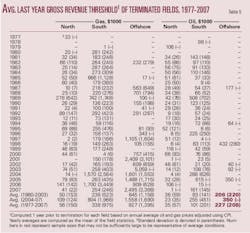Poten: Abu Dhabi gas demand could limit sour gas for LNG
Abu Dhabi Gas Liquefaction Co. is considering plans to increase LNG production at its complex on Das Island beyond 2019, when its 4.7-million tonne/year LNG sales contract with Tokyo Electric Power Co. (Tepco) expires, according to Poten & Partners, New York, an industry consultancy.
The expansion option would include replacing smaller existing trains with a much larger new one. It would depend upon expanding gas production to cover growing domestic demand and reinjection into oil fields, while freeing up extra offshore gas for LNG export.
With domestic energy demand growing at 10%/year, said Poten, Abu Dhabi has decided to move forward with a plan to invest as much as $50 billion in developing large onshore and shallow-water sour-gas reserves. But freeing up extra gas for LNG could prove to be a very tall order, according to Poten’s analysis.
Consumption, plans
Standing at more than 6 trillion cu m, the UAE’s gas reserves are the world’s fifth largest. Much of the gas, however, is either already locked into the gas caps in Abu Dhabi’s oil fields or needed for reinjection.
With official oil reserves of 98 billion bbl, the gas reinjection requirement will continue for many years. Abu Dhabi National Oil Co. (ADNOC) injects 18 billion cu m (bcm)/year into its oil fields; this is projected to increase by 8%/year through 2020.
With the country almost exclusively dependent on gas-fueled electric power generation, says Poten, total gas consumption is projected to reach close to 90 bcm/year by 2018, doubling the 50 bcm including reinjection used in 2008. The UAE has already tapped gas supplies from Qatar via the Dolphin pipeline to meet its needs, but its own large sour-gas reserves in the past had been considered too costly to develop.
ADNOC has now decided to go ahead with the onshore Shah sour-gas development, although it is hoping to reduce the cost of this 1-bcfd, $10-12 billion project by 30%. ADNOC and partner ConocoPhillips signed the joint-venture agreement on July 9 (OGJ Online, July 10, 2009).
The project consists of developing wells, pipelines, and gas plants with corrosion-resistant material throughout to handle 23% hydrogen sulfide and 10% carbon dioxide gas. The sulfur and condensates would be removed and exported through the port of Ruwais, while the treated lean gas would be fed back into the domestic market.
This level of capital expenditure implies a cost of $4/MMbtu for the gas, says Poten. In hopes of lowering these costs, ADNOC issued tenders for four large construction packages even before concluding a final agreement with ConocoPhillips. The tenders cover gas gathering systems, wells, gas pipelines, processing plant, off site facilities, utilities, and sulfur recovery. Officials expect the project to start up in 2015.
Sulfur pipeline
Notably missing, Poten points out, is a tender for a 136-km liquid-sulfur pipeline connecting the Shah field to Ruwais, where the sulfur, more than 4.2 million tonnes/year, is to be granulated and exported to global markets. It is understood the sulfur pipeline package was not released due to a lack of qualified bidders.
Sulfur is already trucked from the Habshan gas-treatment plants to Ruwais. That option is hardly viable for the expansion, says Poten, as it would add more than 600/day 20-tonne truckloads of molten sulfur to the traffic on the main western highway. Any delays in the pipeline would therefore be controversial.
Once Qatar’s current projects are fully operational, the gulf area will be exporting huge quantities of sulfur, perhaps more than can be absorbed in the global market, according to Poten’s analysis. The alternative to exporting would be to cast the sulfur in giant blocks in the desert, an option that has not been acceptable to ADNOC in the past but would remove the need for the pipeline or trucking.
IGD
Receiving much less publicity is the $7-8 billion Integrated Gas Development project (OGJ Online, July 16, 2009). IGD will generate an additional 1 bcfd (10.34 bcm/year) through construction of a 38-km pipeline from offshore fields to Das Island where the gas will be partially processed. It will then be piped to an onshore plant in Ruwais for final processing and use in the domestic market.
The project is scheduled for completion by 2014. ADNOC has awarded a $402-million engineering, procurement, and fabrication contract to majority government-owned National Petroleum Construction Co. The contract covers part of the offshore pipeline construction and is scheduled for completion by mid-2012.
ADNOC plans an additional four tender package releases for IGD in the next few months, covering gas development work in the onshore Bab field and the offshore Umm Shaif field.
IGD’s first phase will deliver 500 MMcfd from Bab, followed by a second 500-MMcfd offshore phase. The offshore component reduces potential gas reserves available for any future LNG production increase at Das Island, signaling the importance to ADNOC of meeting the demand for domestic gas.
Meanwhile, ADNOC is taking measures to fill an immediate supply gap. The week of July 20, the firm announced a new contract for Qatar to supply 400 MMcfd of “interruptible” gas via the Dolphin pipeline, which currently delivers 2 bcfd of Qatari North field gas from Ras Laffan to Abu Dhabi. The pipeline has 1.2 bcfd of unused capacity and the contract is intended to supply gas in the summer to meet peak power-generation demand.
Elsewhere in the UAE, Golar LNG plans to station its 125,000 cu m Golar Freeze as a floating regasification and storage unit at Jebel Ali for 10 years from 2011 to fuel growing power demand (OGJ, July 27, 2009, p. 33).

